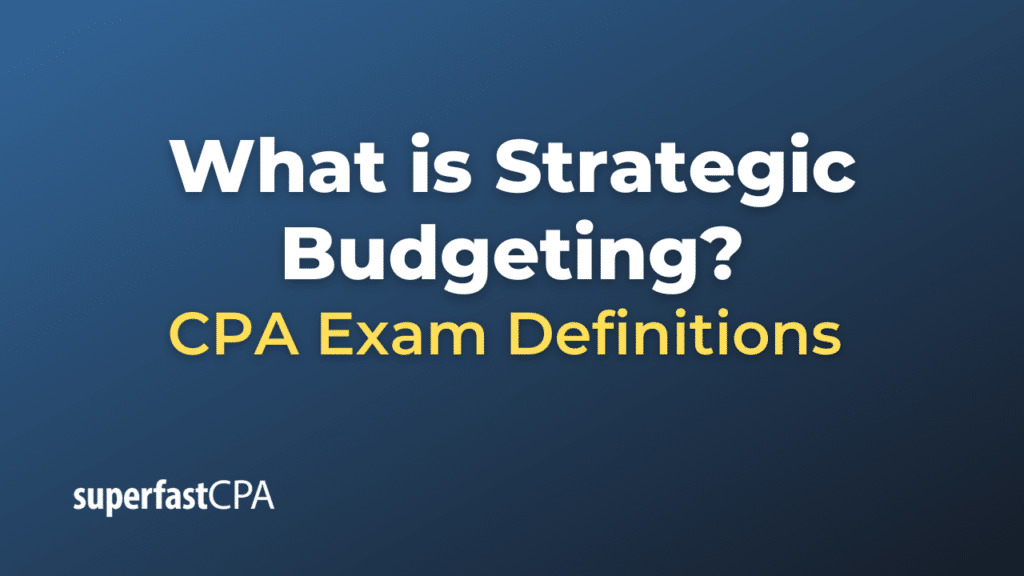Strategic Budgeting
Strategic budgeting is the process of creating a detailed financial plan that aligns with the long-term strategic goals of an organization. It’s a forward-looking approach that integrates strategic planning with budgeting processes to ensure that financial allocations support the company’s objectives and vision. Strategic budgeting extends beyond traditional budgeting by focusing on the big picture and long-term goals, rather than just immediate operational needs.
Key components and concepts of strategic budgeting include:
- Alignment with Strategy: The budget is developed in direct alignment with the organization’s strategic goals, ensuring resources are allocated to initiatives that support these goals.
- Long-term Perspective: While traditional budgets typically focus on a one-year horizon, strategic budgets often consider a longer timeframe, sometimes 3-5 years or even longer.
- Scenario Planning: Given the longer time horizons, strategic budgeting often incorporates scenario planning to account for different potential future situations or market conditions.
- Performance Metrics : These budgets set key performance indicators (KPIs) and targets that align with the strategic objectives. Progress is then monitored against these KPIs.
- Cross-functional Collaboration: Developing a strategic budget often involves collaboration across various departments to ensure all aspects of the organization are moving in tandem towards the strategic goals.
- Flexibility: Given the fast-changing nature of business environments, strategic budgets are often revisited and adjusted as necessary to account for changes in the marketplace or organization.
- Prioritization: Resources are limited, so strategic budgeting involves prioritizing projects and initiatives based on their alignment with strategic goals and their potential return on investment.
Example of Strategic Budgeting
Let’s delve into a detailed example of strategic budgeting for a fictional company.
Scenario: GreenTech Innovations
Company Profile: GreenTech Innovations is a mid-sized company specializing in renewable energy products. Given the global push towards sustainability, the company’s leadership has decided to focus on expanding its solar energy products over the next five years.
Strategic Goal: Capture 15% of the regional solar energy market in the next five years and become the preferred brand for residential solar solutions.
Strategic Budgeting Process:
- Market Research & Development:
- Expansion of Production Capacity:
- Set aside funds for the expansion of the manufacturing facility.
- Invest in state-of-the-art machinery to increase production capabilities and efficiency.
- Marketing & Branding:
- Dedicate a significant portion of the budget for marketing campaigns focused on the benefits of solar energy and GreenTech’s advanced solutions.
- Plan for hosting workshops and educational webinars on solar energy adoption.
- Collaborate with influencers and eco-friendly advocates to promote the brand.
- Talent Acquisition & Training:
- Allocate funds for hiring experts in solar technology.
- Budget for training existing staff on the latest solar technologies and installation techniques.
- Distribution & Partnerships:
- Invest in establishing partnerships with homebuilders and contractors to incorporate GreenTech’s solar solutions in new constructions.
- Strengthen the distribution network to ensure product availability across the region.
- Scenario Planning:
- Set aside contingency funds for potential challenges like regulatory changes, import tariffs on raw materials, or sudden shifts in market demand.
- Plan for potential opportunities, such as government subsidies or partnerships with municipalities.
- Performance Metrics:
- Establish KPIs like the number of solar panels sold, growth in brand awareness, and customer satisfaction scores.
- Dedicate a portion of the budget for periodic market surveys and feedback mechanisms.
Outcome:
By the end of Year 1, GreenTech Innovations sees an uptick in demand, owing to its aggressive marketing campaigns and improved product line. The strategic budgeting process ensures that they are not just reacting to immediate operational needs but are proactively steering the company towards their long-term vision. Regularly revisiting the budget and making adjustments based on the changing landscape keeps GreenTech agile and aligned with its strategic goal.
This example demonstrates how GreenTech Innovations ties its financial planning directly to its broader strategy, ensuring that every dollar spent is an investment towards achieving its long-term objectives.













